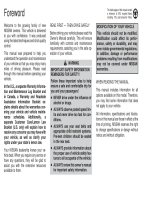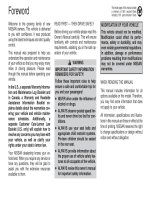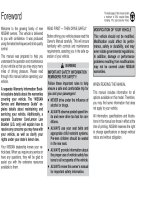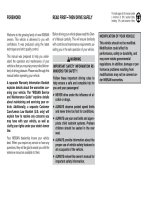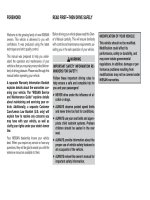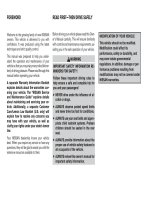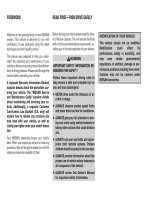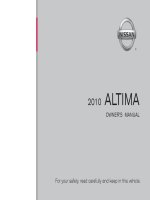NISSAN ALTIMA HYBRID 2011 OWNER MANUAL SÁCH HƯỚNG dẫn sử DỤNG
Bạn đang xem bản rút gọn của tài liệu. Xem và tải ngay bản đầy đủ của tài liệu tại đây (3.83 MB, 422 trang )
®
2011 ALTIMA HYBRID
OWNER’S MANUAL
For your safety, read carefully and keep in this vehicle.
2011 NISSAN ALTIMA HYBRID HL32-D
HL32-D
Printing : August 2010 (06)
Publication No.: OM0E 0L32U2
Printed in U.S.A.
OM1E HL32U0
Welcome to the growing family of new NISSAN
owners. This vehicle is delivered to you with
confidence. It was produced using the latest
techniques and strict quality control.
This manual was prepared to help you under-
stand the operation and maintenance of your
vehicle so that you may enjoy many miles (kilome-
ters) of driving pleasure. Please read through this
manual before operating your vehicle.
A separate Warranty Information Booklet
explains details about the warranties cov-
ering your vehicle. The “NISSAN Service
and Maintenance Guide” explains details
about maintaining and servicing your ve-
hicle. Additionally, a separate Customer
Care/Lemon Law Booklet (U.S. only) will
explain how to resolve any concerns you
may have with your vehicle, as well as
clarify your rights under your state’s lemon
law.
Your NISSAN dealership knows your vehicle
best. When you require any service or have any
questions, they will be glad to assist you with the
extensive resources available to them.
Before driving your vehicle, please read this Own-
er’s Manual carefully. This will ensure familiarity
with controls and maintenance requirements, as-
sisting you in the safe operation of your vehicle.
WARNING
IMPORTANT SAFETY INFORMATION RE-
MINDERS FOR SAFETY!
Follow these important driving rules to
help ensure a safe and comfortable trip
for you and your passengers!
● NEVER drive under the influence of al-
cohol or drugs.
● ALWAYS observe posted speed limits
and never drive too fast for conditions.
●
ALWAYS give your full attention to driving
and avoid using vehicle features or taking
other actions that could distract you.
● ALWAYS use your seat belts and appro-
priate child restraint systems. Preteen
children should be seated in the rear
seat.
● ALWAYS provide information about the
proper use of vehicle safety features to
all occupants of the vehicle.
● ALWAYS review this Owner’s Manual
for important safety information.
MODIFICATION OF YOUR VEHICLE
This vehicle should not be modified.
Modification could affect its
performance, safety or durability, and
may even violate governmental
regulations. In addition, damage or per-
formance problems resulting from modi-
fications may not be covered under
NISSAN warranties.
FOREWORD READ FIRST—THEN DRIVE SAFELY
This manual includes information for all options
available on this model. Therefore, you may find
some information that does not apply to your
vehicle.
All information, specifications and illustrations in
this manual are those in effect at the time of
printing. NISSAN reserves the right to change
specifications or design without notice and with-
out obligation.
IMPORTANT INFORMATION ABOUT
THIS MANUAL
You will see various symbols in this manual. They
are used in the following ways:
WARNING
This is used to indicate the presence of a
hazard that could cause death or serious
personal injury. To avoid or reduce the
risk, the procedures must be followed
precisely.
CAUTION
This is used to indicate the presence of a
hazard that could cause minor or moder-
ate personal injury or damage to your ve-
hicle. To avoid or reduce the risk, the pro-
cedures must be followed carefully.
If you see this symbol, it means “Do not do this”
or “Do not let this happen.”
If you see a symbol similar to these in an illustra-
tion, it means the arrow points to the front of the
vehicle.
Arrows in an illustration that are similar to these
indicate movement or action.
Arrows in an illustration that are similar to these
call attention to an item in the illustration.
CALIFORNIA PROPOSITION 65
WARNING
WARNING
Engine exhaust, some of its constituents,
and certain vehicle components contain
or emit chemicals known to the State of
California to cause cancer and birth de-
fects or other reproductive harm. In addi-
tion, certain fluids contained in vehicles
and certain products of component wear
contain or emit chemicals known to the
State of California to cause cancer and
birth defects or other reproductive harm.
CALIFORNIA PERCHLORATE
ADVISORY
Some vehicle parts, such as lithium batter-
ies, may contain perchlorate material. The
following advisory is provided: “Perchlorate
Material – special handling may apply, See
www.dtsc.ca.gov/hazardouswaste/perchlorate.”
APD1005
WHEN READING THE MANUAL
HEV-2
BLUETOOTH is a
trademark owned by
Bluetooth SIG, Inc.,
U.S.A. and licensed
to Visteon and
Clarion.
XM Radio requires
subscription, sold
separately. Not
available in Alaska,
Hawaii or Guam.
For more
information, visit
www.xmradio.com.
© 2010 NISSAN NORTH AMERICA, INC.
All rights reserved. No part of this Owner’s
Manual may be reproduced or stored in a retrieval
system, or transmitted in any form, or by any
means, electronic, mechanical, photocopying,
recording or otherwise, without the prior written
permission of Nissan North America, Inc.
HEV-3
NISSAN CARES
Both NISSAN and your NISSAN dealer are dedicated to serving all your automotive needs. Your satisfaction with your vehicle and your NISSAN dealer are
our primary concerns. Your NISSAN dealer is always available to assist you with all your automobile sales and service needs.
However, if there is something that your NISSAN
dealer cannot assist you with or you would like to
provide NISSAN directly with comments or
questions, please contact the NISSAN Con-
sumer Affairs Department using our toll-free
number:
For U.S. customers
1-800-NISSAN-1
(1-800-647-7261)
For Canadian customers
1-800-387-0122
The Consumer Affairs Department will ask for the
following information:
– Your name, address, and telephone number
– Vehicle identification number (attached to the
top of the instrument panel on the driver’s
side)
– Date of purchase
– Current odometer reading
– Your NISSAN dealer’s name
– Your comments or questions
OR
You can write to NISSAN with the information at:
For U.S. customers
Nissan North America, Inc.
Consumer Affairs Department
P.O. Box 685003
Franklin, TN 37068-5003
For Canadian customers
Nissan Canada Inc.
5290 Orbitor Drive
Mississauga, Ontario L4W 4Z5
or via e-mail at:
For U.S. customers
For Canadian customers
We appreciate your interest in NISSAN and thank you for buying a quality NISSAN vehicle.
NISSAN CUSTOMER CARE PROGRAM
Table of
Contents
HEV Overview
Illustrated table of contents
Safety—Seats, seat belts and supplemental restraint system
Instruments and controls
Pre-driving checks and adjustments
Monitor, climate, audio, phone and voice recognition systems
Starting and driving
In case of emergency
Appearance and care
Maintenance and do-it-yourself
Technical and consumer information
Index
HEV
0
1
2
3
4
5
6
7
8
9
10
HEV Overview
Hybrid System HEV-2
High voltage battery HEV-2
High voltage cautions HEV-2
Road accident cautions HEV-3
Emergency shut off system HEV-3
Energy Monitors HEV-3
Power meter HEV-4
High voltage battery status meter HEV-4
Energy flow
(vehicles equipped with navigation) HEV-4
Fuel Economy History
(vehicles equipped with navigation) HEV-5
Starting the Hybrid System HEV-7
Efficient use of your vehicle HEV-7
Hybrid vehicle precautions HEV-8
High voltage components HEV-8
Hybrid vehicle characteristics HEV-9
The Hybrid System combines the power of a
gasoline engine and an electric motor to minimize
fuel consumption and emissions.
Depending on driving conditions, the vehicle runs
on a combination of the gasoline engine and the
electric motor, whichever is best for those condi-
tions.
Because the gasoline engine charges the high
voltage battery as needed, the battery does not
have to be charged from an outside source like an
all-electric vehicle.
WARNING
Your vehicle contains a sealed Nickel-
Metal hydride high voltage battery. If dis-
posed of improperly, it is hazardous to the
environment and there is a risk of severe
burns and electrical shock that may result
in serious injury or death.
The high voltage battery is used to drive the
electric motors in the Hybrid System.
The high voltage battery has a limited service life.
Contact your NISSAN dealer for information
about recycling or disposal of the battery.
WARNING
● The hybrid system uses high voltage up
to 650 V. The system can be hot while
and after starting. Be careful of both the
high voltage and the high temperature.
Obey the caution labels attached to the
vehicle.
● Never touch, disassemble, remove or
replace the high voltage parts, cables
and their connectors. High voltage
cables are orange. Touching, disassem-
bling, removing or replacing those parts
and cables can cause severe burns or
electric shock that may result in serious
injury or death.
● Never try to remove the service discon-
nect located in the trunk on the lower
right-hand side. The service disconnect
is used only when the vehicle is ser-
viced by trained technicians wearing
personal protection equipment and is
part of the high voltage system. Touch-
ing the service disconnect can cause
severe burns or electric shock that may
result in serious injury or death.
HYBRID SYSTEM HIGH VOLTAGE BATTERY HIGH VOLTAGE CAUTIONS
HEV-2 HEV Overview
WARNING
● Pull your vehicle off the road, put the
transmission in the P (Park) position,
apply the parking brake and turn the
Hybrid System off.
● Check to see if there are exposed high
voltage parts and cables. Never touch
the parts and cables. See “High voltage
components”, later in this section for
the locations of the high voltage parts
and cables.
● To avoid personal injury, do not touch
high voltage wiring, connectors and
high voltage parts (inverter unit, high
voltage battery etc.).
● If exposed electric wires are visible in-
side or outside of your vehicle, an elec-
tric shock may occur. Never touch the
electric wires.
● Inspect the ground under the vehicle. If
liquid has leaked onto the ground, the
fuel system may have been damaged.
Leave the vehicle as soon as possible.
● Never touch fluid leaks inside or out-
side the vehicle. The leak may be strong
alkaline electrolyte from the high volt-
age battery. If it contacts your skin or
eyes, wash it off immediately with a
large amount of water or if possible,
boric acid solution. Get immediate
medical attention to help avoid serious
injury.
● If a fire occurs in the hybrid vehicle,
leave the vehicle as soon as possible.
Never use a fire extinguisher that is not
meant for use on electric fires. Using
even a small amount of water may be
also dangerous.
● If your vehicle needs to be towed, do it
with the front wheels raised. If the front
wheels are on the ground when towing,
the traction motor may generate elec-
tricity. This may damage the Hybrid Sys-
tem components and cause a fire.
EMERGENCY SHUT OFF SYSTEM
The emergency shut off system automatically
turns off the high voltage current in certain frontal
collisions. This is to minimize the risk of electrical
short circuits. If the system activates, your vehicle
will not restart. To restart the Hybrid System,
contact a NISSAN dealer.
The Hybrid System monitors the status of power
being sent to the traction motor and the battery
state of charge. The status is shown on the hybrid
power meter and high voltage battery status me-
ter. System status can also be shown on the
navigation system display (if so equipped) when
the screen is in the Energy Flow mode or
energy/fuel history mode.
ROAD ACCIDENT CAUTIONS ENERGY MONITORS
HEV Overview HEV-3
POWER METER
The power meter indicates the total amount of
power in the hybrid system.
For additional information, see “Meters and
gauges”in the “Instruments and controls” section
of this manual.
HIGH VOLTAGE BATTERY STATUS
METER
The gauge indicates the amount of power in the
high voltage battery.
For additional information, see “Meters and
gauges”in the “Instruments and controls” section
of this manual.
ENERGY FLOW (vehicles equipped
with navigation)
When you use this system, make sure the Hybrid
System is in the ready mode.
If you use the system with the Hybrid Sys-
tem off (ignition switch placed in the ACC
position) for a long time, it will use up all
the 12–volt battery power, and the engine
will not start.
Energy flow for various operating modes can be
displayed on the navigation system monitor. The
screen must be set to the Energy Flow mode or
the Fuel Economy History mode.
LIC1109 WIC1123
HEV-4 HEV Overview
Press the INFO button on the control panel, then
touch the “Energy Flow” key on the screen.
This is an example of the Energy Flow display.
The Energy Flow display varies, depending on
the condition of the vehicle. The graphic does not
reflect the actual motion of the vehicle.
The Energy Flow will display:
● When the vehicle is powered only by the
traction motor.
● When the vehicle is powered by both the
traction motor and the gasoline engine.
● When the vehicle is powered only by the
gasoline engine.
● When the vehicle is regenerating and charg-
ing the high voltage battery.
● When there is no energy flow in the vehicle.
FUEL ECONOMY HISTORY (vehicles
equipped with navigation)
The Fuel Economy History screen appears in the
display with the navigation system when the
screen is in the Fuel Economy History mode.
LHV2000 LHV2001
HEV Overview HEV-5
Press the INFO button on the control panel, and
then touch the “Fuel Economy History”key on the
screen.
The Fuel Economy History can be displayed on
the navigation system monitor. The screen must
be set to the Energy Flow mode or the Fuel
Economy History mode. This displays the vehi-
cle’s average fuel consumption and regenerative
electric power at 5 minute intervals.
The displayed values on the screen indicate gen-
eral driving conditions. Accuracy varies with driv-
ing habits and road conditions.
1. Regenerated energy in the past 30 minutes:
The regenerated energy in the past 30 min-
utes is indicated with symbols. One symbol
indicates 50 watt hours. The energy of 50
watt hours illuminates a 50 watt bulb for an
hour.
2. Fuel consumption in the past 30 minutes:
Fuel consumption in the past 30 minutes is
displayed.
3. Current fuel consumption (Latest column):
The current fuel consumption is calculated
and displayed based on distance and fuel
consumption.
NOTE:
Information shown in the yellow column
means current (within 5 minutes) and infor-
mation shown in the blue columns means
past (more than 5 minutes).
LHV2000 LHV2002
HEV-6 HEV Overview
Place the ignition switch in the ON position.
Depress the brake pedal and push the ignition
switch when the transmission is in the P (Park)
position to start the Hybrid System.
The READY light illuminates indicating that the
vehicle is ready to be driven. If the ambient tem-
perature is low, the READY may flash and may
take time until the READY light stays on. For
details, see “Starting the Hybrid System” in the
“Starting and driving” section of this manual.
As long as the READY light remains on you can
drive your vehicle using the traction motor even
though the gasoline engine may not be running.
Drive your vehicle with smooth accelera-
tion and deceleration.
● While driving, energy is recovered through
the regenerative brake as the vehicle decel-
erates. However, for most efficient use, do
not accelerate or decelerate your vehicle
more than necessary.
● Avoid abrupt acceleration and deceleration.
● The power of the high voltage battery can be
checked on the high voltage battery status
meter. See “High voltage battery status me-
ter” in this section for details. Gradual or
non-abrupt acceleration and deceleration
will make more effective use of the traction
motor without having to use gasoline engine
power.
● When parking, be sure to place the shift
selector in the P (Park) position. While driv-
ing, place the shift selector in the D (Drive)
position.
● The Hybrid System recharges the high volt-
age battery as necessary. However, the Hy-
brid System can not charge the high voltage
battery when the transmission is in the N
(Neutral) position even if the engine is run-
ning.
● If the high voltage battery becomes dis-
charged, the engine will run for a longer
period of time. Do not keep the transmission
in the N (Neutral) position with the system in
the ready mode.
NOTE:
The gasoline engine starts and stops auto-
matically. It may stop during low load driv-
ing, deceleration or when the vehicle is
stopped.
As long as the READY light remains on, you
can drive your vehicle using the traction
motor even with the gasoline engine
stopped.
The gasoline engine may not stop auto-
matically in the following conditions:
● During gasoline engine warm-up.
● During high voltage battery charging.
● During high or low high voltage battery
temperature.
STARTING THE HYBRID SYSTEM EFFICIENT USE OF YOUR VEHICLE
HEV Overview HEV-7
HIGH VOLTAGE COMPONENTS
WARNING
● The Hybrid System uses high voltage up
to 650 V. The system can be hot while
and after starting. Be careful of both the
high voltage and the high temperature.
Obey the caution labels attached to the
vehicle.
● Never touch, disassemble, remove or
replace the high voltage parts, cables
and their connectors. High voltage
cables are orange. Touching, disassem-
bling, removing or replacing those parts
and cables can cause severe burns or
electric shock that may result in serious
injury or death.
LHV0005
HYBRID VEHICLE PRECAUTIONS
HEV-8 HEV Overview
1. Air conditioner compressor location
2. Electric power steering location
3. 42V DC/DC converter
4. High voltage battery and 12V DC/DC
converter
5. Service disconnect
6. High voltage harnesses
7. Traction motor location
8. Inverter unit
The Hybrid System uses high voltage up to 650
V. High voltage components are indicated in the
illustration. High voltage cables are orange. The
system can be hot while and after starting. Be
careful of both the high voltage and the high
temperature.
HYBRID VEHICLE
CHARACTERISTICS
WARNING
● Pay special attention to pedestrians
when the vehicle is powered only by the
traction motor. Because there is no en-
gine noise, pedestrians may not know
the vehicle is moving or about to move
and step into the direction of vehicle
travel.
● When you leave your vehicle, be sure to
turn off the Hybrid System.
● Be sure to put the transmission in the P
(Park) position because the vehicle can
move when the READY light is on even
if the engine is stopped. When the
READY light is on, do not leave your
vehicle in a shift position other than the
P (Park) position. The vehicle will creep
and start abruptly if the accelerator
pedal is depressed by mistake. This may
cause serious injury or death.
CAUTION
● If the vehicle is parked for a long time,
the high voltage battery will discharge
gradually. To keep the high voltage bat-
tery in good condition, drive the vehicle
at least once every several months for
at least 30 minutes or ten miles. If the
high voltage battery becomes fully dis-
charged and the vehicle will not start
even with a jump-start to the 12-volt
system, contact your NISSAN dealer.
● After the 12-volt battery is discon-
nected, run down, or replaced, the
gasoline engine may not stop even
while the vehicle is powered only by the
traction motor. If this condition contin-
ues for several days, take the vehicle to
your NISSAN dealer.
● Do not load large amounts of water in
open containers (aquariums or buck-
ets) into the vehicle. If the water spills
onto the high voltage battery, it may
cause a short circuit and damage the
battery.
High voltage parts and cables on the hybrid
vehicles emit approximately the same amount of
electromagnetic waves as the conventional
gasoline powered vehicles or home electronic
appliances despite of their electromagnetic
shieldings. Unwanted noise may occur in the
reception of a mobile two-way radio.
Charging the high voltage battery while driving is
important. The vehicle cannot run if the high
voltage battery is discharged. In the N (Neutral)
position, the high voltage battery does not re-
charge. Leaving the transmission in the N (Neu-
tral) position for an extended period of time may
discharge the high voltage battery. The high volt-
age battery recharges when the shift selector is
in any position other than N (Neutral). Repeated
HEV Overview HEV-9
acceleration also consumes high voltage battery
power, resulting in poor acceleration. Battery
power can be restored by driving at a constant
speed.
When you put the shift selector in the B (Brake)
position and take your foot off the accelerator
pedal, engine braking will be applied. However,
during high speed driving you may feel that en-
gine braking is less effective than that of an
ordinary vehicle. This is normal.
Because the vehicle is powered by both the
gasoline engine and the traction motor, you may
hear a sound coming from the engine compart-
ment, high voltage battery, transmission or the
regenerative brakes. When the gasoline engine
starts and stops with the Hybrid System on, you
may feel a vibration. When accelerating rapidly,
the engine noise may rise. A noise may also be
heard while braking. These are normal character-
istics of the hybrid vehicle.
An air vent is located on the rear parcel shelf
᭺
A
to cool the high voltage battery. If the vent is
covered, the battery will overheat resulting in
reduced output performance of the Hybrid Sys-
tem.
You may hear the noise of the cooling fan from the
air vent.
CAUTION
Do not place objects over or into the air
vent. The high voltage battery may over-
heat and be damaged.
LHV0004 LHV0006
HEV-10 HEV Overview
CAUTION
Do not load large amounts of water in
open containers (aquariums or buckets)
into the vehicle. If the water spills onto the
high voltage battery, it may cause a short
circuit and damage the battery.
CAUTION
Do not allow any liquid to get on or in the
air vent. It may cause a short circuit and
damage the high voltage battery.
LHV0007 LHV0008
HEV Overview HEV-11
MEMO
HEV-12 HEV Overview
0 Illustrated table of contents
Air bags, seat belts and child restraints 0-2
Exterior front 0-3
Exterior rear 0-4
Passenger compartment 0-5
Instrument panel 0-6
Engine compartment check locations . . . 0-7
Warning/indicator lights 0-8
1. Top tether strap anchor (P. 1-22)
2. Rear seat belts (P. 1-10)
3. Roof-mounted curtain side-impact
supplemental air bag (P. 1-35)
4. Front seat-mounted side-impact
supplemental air bag (P. 1-35)
5. Head Restraints (P. 1-6)
6. Front seat belts (P. 1-10)
7. Side-impact air bag pressure sensor
(driver’s side shown; passenger’s side
similar) (P. 1-50)
8. Supplemental front-impact air bags
(P. 1-35)
9. Seats (P. 1-2)
10. Occupant classification sensor
(pattern sensor) (P. 1-43)
11. Seat belt with pretensioner (P. 1-48)
12. LATCH (Lower Anchors and Tethers for
CHildren) system (P. 1-20)
See the page number indicated in paren-
theses for operating details.
LII2001
AIR BAGS, SEAT BELTS AND CHILD
RESTRAINTS
0-2 Illustrated table of contents
1. Power windows (P. 2-41)
2. Windshield (P. 8-18)
3. Windshield wiper and washer switch
(P. 2-29)
4. Engine hood (P. 3-18)
5. Tie down (P. 6-13)
6. Headlight and turn signal switch
(P. 2-30)
7. Replacing bulbs (P. 8-25)
8. Tire pressure (P. 8-32)
9. Flat tire (P. 6-2)
10. Tire chains (P. 8-39)
11. Mirrors (P. 3-24)
12. Door locks, NISSAN Intelligent Key ™ ,
keys (P. 3-4, 3-2, 3-2)
See the page number indicated in paren-
theses for operating details.
WII0179
EXTERIOR FRONT
Illustrated table of contents 0-3
1. Antenna (P. 4-83)
2. Rear window and outside mirror
(if so equipped) defroster switch
(P. 2-30)
3. Interior trunk lid release (P. 3-19)
4. Trunk lid (P. 3-18)
5. Vehicle loading (P. 9-12)
6. Exterior trunk lid release (P. 3-13)
7. Replacing bulbs (P. 8-25)
8. Fuel-filler cap, fuel
recommendation (P. 3-20, P. 9-28)
9. Fuel-filler door (P. 3-20)
10. Child safety rear door lock (P. 3-6)
WII0104
EXTERIOR REAR
0-4 Illustrated table of contents
1. Center armrest (P. 1-5)
2. Moonroof (if so equipped) (P. 2-44)
3. Sun visors (P. 3-23)
4. Interior lights, illuminated entry (P. 2-46)
5. HomeLinkா universal transceiver
(if so equipped) (P. 2-48)
6. Automatic anti-glare rearview mirror
(if so equipped) (P. 3-24)
7. Glove box (P. 2-39)
8. Front cup holders (P. 2-38)
9. Front console (P. 2-39)
10. Front seat (P. 1-2)
See the page number indicated in paren-
theses for operating details.
WII0105
PASSENGER COMPARTMENT
Illustrated table of contents 0-5
1. Vents (P. 4-18)
2. Headlight/turn signal switch (P. 2-30)
3. Steering wheel switch for audio control
(if so equipped)/Bluetoothா Hands-free
Phone System (if so
equipped)(P. 4-81, 4-85)
4. Meters and gauges (P. 2-3)
5. Driver supplemental air bag/horn
(P. 1-35, 2-34)
6. Cruise control main/set switch
(P. 5-15)
7. Windshield wiper/washer switch
(P. 2-29)
8. Ignition switch (P. 5-7)
9. Hazard warning flasher switch (P. 2-34)
10. Front passenger air bag status light
(P. 2-15)
11. Front passenger supplemental air bag
(P. 1-35)
12. Glove box (P. 2-39)
13. Navigation system* (if so equipped)
(P. 4-2)
14. Heater and air conditioner (P. 4-19)
15. Shift selector (P. 5-11)
16. Covered storage box (P. 2-40)
17. Audio system controls (P. 4-22)
18. Tilt/telescopic steering wheel
controls (P. 3-22)
19. Vehicle information display controls
(P. 2-18)
20. Hood release (P. 3-18)
21. NISSAN Intelligent Key™ port (P. 3-2)
Trunk opener (P. 3-18)
*: Refer to the separate Navigation System Own-
er’s Manual (if so equipped).
See the page number indicated in paren-
theses for operating details.
WIC1601
INSTRUMENT PANEL
0-6 Illustrated table of contents
